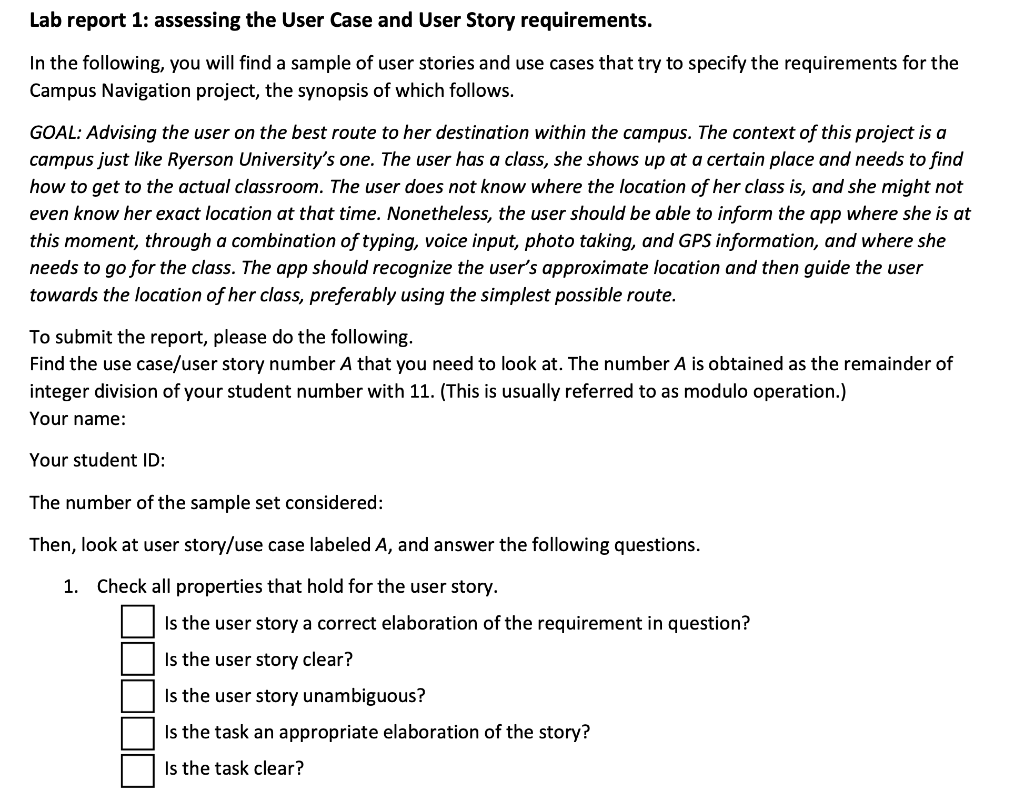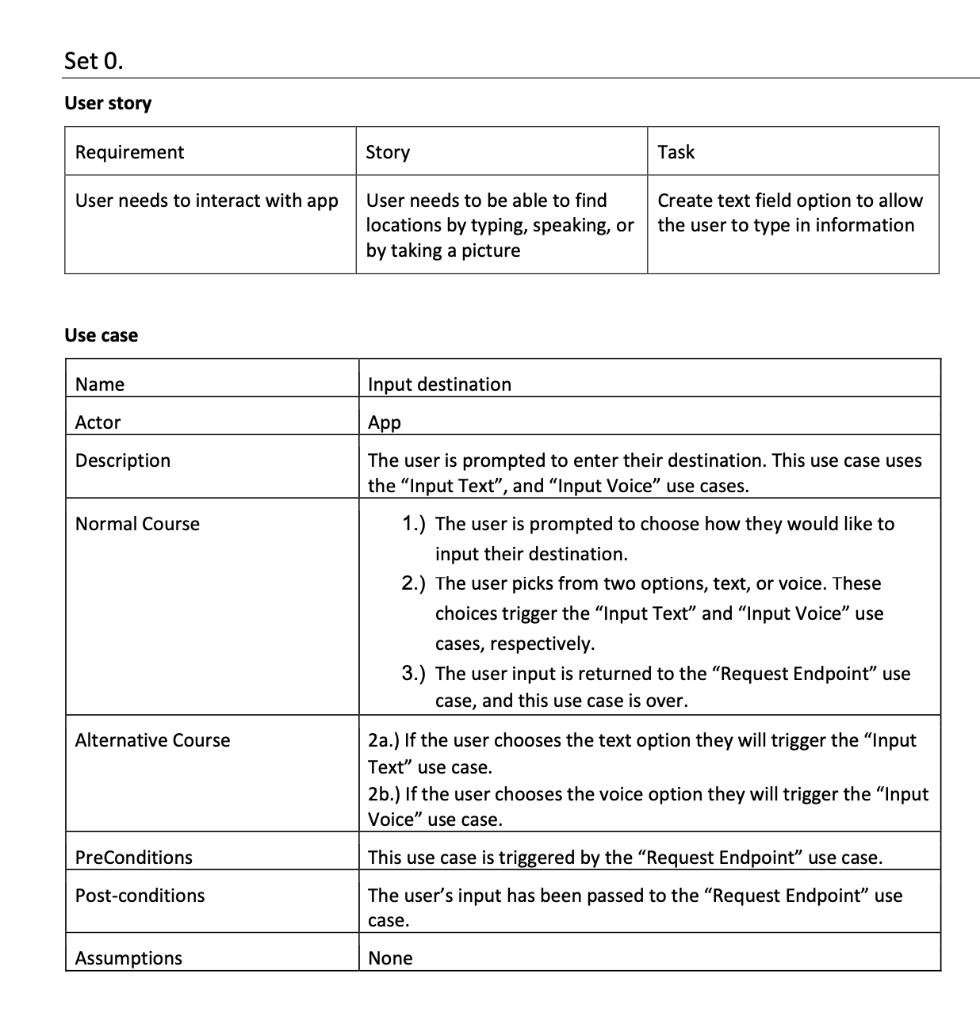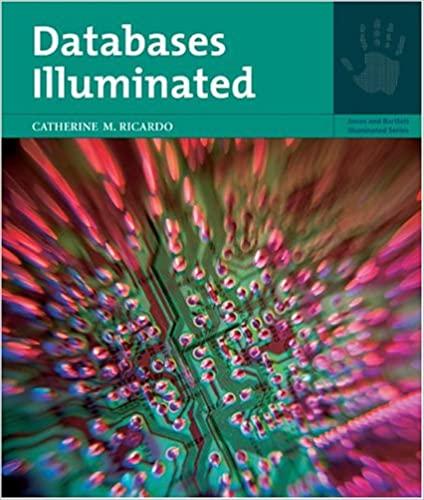


Lab report 1: assessing the User Case and User Story requirements. In the following, you will find a sample of user stories and use cases that try to specify the requirements for the Campus Navigation project, the synopsis of which follows. GOAL: Advising the user on the best route to her destination within the campus. The context of this project is a campus just like Ryerson University's one. The user has a class, she shows up at a certain place and needs to find how to get to the actual classroom. The user does not know where the location of her class is, and she might not even know her exact location at that time. Nonetheless, the user should be able to inform the app where she is at this moment, through a combination of typing, voice input, photo taking, and GPS information, and where she needs to go for the class. The app should recognize the user's approximate location and then guide the user towards the location of her class, preferably using the simplest possible route. To submit the report, please do the following. Find the use case/user story number A that you need to look at. The number A is obtained as the remainder of integer division of your student number with 11. (This is usually referred to as modulo operation.) Your name: Your student ID: The number of the sample set considered: Then, look at user story/use case labeled A, and answer the following questions. 1. Check all properties that hold for the user story. Is the user story a correct elaboration of the requirement in question? Is the user story clear? Is the user story unambiguous? Is the task an appropriate elaboration of the story? Is the task clear? 1. Check all properties that hold for the user story. Is the user story a correct elaboration of the requirement in question? Is the user story clear? Is the user story unambiguous? Is the task an appropriate elaboration of the story? Is the task clear? Is the task actionable (i.e., do you think you can begin coding with the information supplied? Is the task too simple or too complex? 2. Check all properties that apply to the use case. The use case is a correct elaboration of the interaction scenario in question. The use case is clear. The use case is unambiguous. The use case is neither too simple nor too complex. All the actors in the use case are correctly identified. The use case contains appropriate main and alternate flows. The use case contains complete preconditions. The use case contains complete postconditions of both kinds. Set 0. User story Requirement Story Task User needs to interact with app User needs to be able to find locations by typing, speaking, or by taking a picture Create text field option to allow the user to type in information Use case Name Input destination Actor App Description Normal Course The user is prompted to enter their destination. This use case uses the "Input Text", and "Input Voice" use cases. 1.) The user is prompted to choose how they would like to input their destination. 2.) The user picks from two options, text, or voice. These choices trigger the "Input Text" and "Input Voice use cases, respectively. 3.) The user input is returned to the "Request Endpoint use case, and this use case is over. Alternative Course 2a.) If the user chooses the text option they will trigger the "Input Text" use case. 2b.) If the user chooses the voice option they will trigger the "Input Voice" use case. PreConditions This use case is triggered by the Request Endpoint" use case. The user's input has been passed to the Request Endpoint use Post-conditions case. Assumptions None Lab report 1: assessing the User Case and User Story requirements. In the following, you will find a sample of user stories and use cases that try to specify the requirements for the Campus Navigation project, the synopsis of which follows. GOAL: Advising the user on the best route to her destination within the campus. The context of this project is a campus just like Ryerson University's one. The user has a class, she shows up at a certain place and needs to find how to get to the actual classroom. The user does not know where the location of her class is, and she might not even know her exact location at that time. Nonetheless, the user should be able to inform the app where she is at this moment, through a combination of typing, voice input, photo taking, and GPS information, and where she needs to go for the class. The app should recognize the user's approximate location and then guide the user towards the location of her class, preferably using the simplest possible route. To submit the report, please do the following. Find the use case/user story number A that you need to look at. The number A is obtained as the remainder of integer division of your student number with 11. (This is usually referred to as modulo operation.) Your name: Your student ID: The number of the sample set considered: Then, look at user story/use case labeled A, and answer the following questions. 1. Check all properties that hold for the user story. Is the user story a correct elaboration of the requirement in question? Is the user story clear? Is the user story unambiguous? Is the task an appropriate elaboration of the story? Is the task clear? 1. Check all properties that hold for the user story. Is the user story a correct elaboration of the requirement in question? Is the user story clear? Is the user story unambiguous? Is the task an appropriate elaboration of the story? Is the task clear? Is the task actionable (i.e., do you think you can begin coding with the information supplied? Is the task too simple or too complex? 2. Check all properties that apply to the use case. The use case is a correct elaboration of the interaction scenario in question. The use case is clear. The use case is unambiguous. The use case is neither too simple nor too complex. All the actors in the use case are correctly identified. The use case contains appropriate main and alternate flows. The use case contains complete preconditions. The use case contains complete postconditions of both kinds. Set 0. User story Requirement Story Task User needs to interact with app User needs to be able to find locations by typing, speaking, or by taking a picture Create text field option to allow the user to type in information Use case Name Input destination Actor App Description Normal Course The user is prompted to enter their destination. This use case uses the "Input Text", and "Input Voice" use cases. 1.) The user is prompted to choose how they would like to input their destination. 2.) The user picks from two options, text, or voice. These choices trigger the "Input Text" and "Input Voice use cases, respectively. 3.) The user input is returned to the "Request Endpoint use case, and this use case is over. Alternative Course 2a.) If the user chooses the text option they will trigger the "Input Text" use case. 2b.) If the user chooses the voice option they will trigger the "Input Voice" use case. PreConditions This use case is triggered by the Request Endpoint" use case. The user's input has been passed to the Request Endpoint use Post-conditions case. Assumptions None









